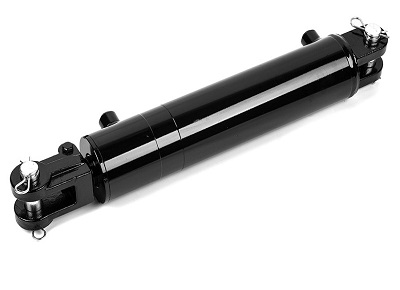A custom telescopic hydraulic cylinder is a specialized hydraulic cylinder with a wide range of applications. Depending on the number of telescopic stages, it can be divided into 2, 3, 4, or 5-stage telescopic cylinders. Depending on the number of liquid supplies needed to complete one work cycle, it can be categorized into single-acting and double-acting multi-stage hydraulic cylinders. Among them, the single-acting multi-stage cylinder is a plunger-type custom telescopic hydraulic cylinder, the double-acting multi-stage hydraulic cylinder is a piston-type custom telescopic hydraulic cylinder, and there is another type where the last stage is a piston and the preceding stages are plungers.
The custom telescopic hydraulic cylinder is made up of two or more piston-type hydraulic cylinders nested together, where the piston rod of the front stage piston cylinder acts as the cylinder tube of the subsequent stage piston cylinder. When pressure oil enters from the rodless chamber, the cylinder tube with the largest effective piston area starts to extend first. When it reaches the end, the cylinder tube with the next largest effective piston area begins to extend. The extension sequence of a telescopic hydraulic cylinder is from large to small, enabling a very long working stroke.
The smaller the effective area of the outer extending cylinder, the faster the extension speed. Therefore, the extension speed transitions from slow to fast, and the corresponding hydraulic thrust changes from large to small. This change in thrust and speed is well-suited to the requirements of various automatic loading and unloading machines for thrust and speed. The retraction sequence is generally from small to large, with the retracted axial length being shorter, occupying less space, and providing a compact structure. It is commonly used in the hydraulic systems of construction and other mobile machinery, such as cranes and dump trucks. This design minimizes the retracted axial length, ensuring hydraulic cylinders for dump trucks or cranes maintain a compact structure—a crucial feature for mobile machinery with limited spatial clearance.
The piston-type double-acting two-stage custom telescopic hydraulic cylinder consists of a first-stage piston assembly with a piston seal ring, the outer wall of the first-stage cylinder piston rod, and the inner wall of the first-stage piston rod, etc. The second-stage piston rod assembly consists of a piston rod, piston, and seals, etc., and the inner wall of the first-stage piston rod acts as the cylinder tube for the second-stage piston rod. The front end cap of the second-stage piston cylinder, which also serves as the guiding component, is simultaneously a part of the first-stage piston rod. Initially, the second-stage small piston is located on top of the first-stage large piston, which is at the bottom of the telescopic tube. When pressure oil is supplied from the right port, the first and second stage piston assemblies simultaneously move upward.
The total stroke of a custom telescopic hydraulic cylinder is the sum of the strokes of its various stages, allowing for a relatively long stroke. When not in use, the entire hydraulic cylinder can be retracted to a very short length, making it widely used in situations where installation dimensions are constrained but a large working stroke is required. The most typical example is the telescopic arm of a vehicle-mounted crane. Additionally, it is also extensively used in the hydraulic supports of dump trucks, cleaning vehicles, and mining machinery.
The hydraulic cylinders of different stages in telescopic custom hydraulic cylinders increase successively in size. When the load is constant, the working pressure of the hydraulic cylinder sequentially increases. During operation, the first-stage hydraulic cylinder of the custom telescopic hydraulic cylinder extends first, and the last-stage cylinder extends last. During retraction, the last-stage hydraulic cylinder retracts first, and the first-stage hydraulic cylinder retracts last.
The inner wall of the front stage piston of a multi-stage hydraulic cylinder serves as the cylinder tube of the next stage hydraulic cylinder, with each stage nested together, resulting in a very compact structure. Additionally, to reduce weight and increase bending strength, the last-stage plunger is often hollow.
As a professional China telescopic cylinder manufacturer, HUTCHIN HYDRAULIC has been designing and manufacturing various hydraulic cylinders for over 20 years worldwide.


